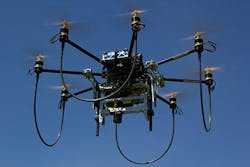TerraLuma project to use Headwall Photonics hyperspectral sensor for SkyJib UAV
Fitchburg, MA--Because they say the richness of imagery data collected via hyperspectral sensing far exceeds that of other methods, researchers working on theTerraLuma project (www.terraluma.net) at the University of Tasmania (www.utas.edu.au) in Australia are partnering with Headwall Photonics to bring hyperspectral technology to their fleet of unmanned aircraft systems (UASs) or unmanned aerial vehicles (UAVs). Headwall Photonics' Micro-Hyperspec sensor will be placed onboard the multi-rotor SkyJib airframe from Droidworx (Waikato, New Zealand).
The TerraLuma research project at the University of Tasmania aims to develop novel tools and algorithms for environmental remote sensing applications and aerial surveys (mapping and monitoring vegetation in remote locations, for example) using UAVs. The university team consists of a senior academic, a postdoc, five PhD students, and two technical officers and says it specializes in UAV sensor integration and image processing for earth-observation applications. The project will uniquely operate and integrate multiple sensors: visible, multispectral and hyperspectral (very near-infrared or VNIR), thermal, and light detection and ranging (LIDAR), to map and monitor different aspects of the environment at ultrahigh resolutions on demand.
Headwall Photonics' Micro-Hyperspec is a compact sensor that meets the payload restrictions of small UAVs while providing the spatial and spectral resolution needed to ‘map’ the environment in detail. Headwall says that size, weight, and power-draw (SWaP) are key considerations for any airborne application and is why Micro-Hyperspec appealed to the TerraLuma team. "Environmental remote sensing and aerial surveying represent the kind of groundbreaking work we're known for," said Arko Lucieer, team leader for the TerraLuma research group. "Our move to hyperspectral fits with our goal to provide the research community with clear, actionable data that can be captured, managed and delivered faster than ever."
David Bannon, CEO of Headwall, said, "Remote sensing utilizing UAV platforms represents a high-growth area of research because airborne platforms combined with small hyperspectral sensors represents an innovative and cost-effective research approach. We're very proud to be working with Dr. Lucieer and play a key role as TerraLuma undertakes aerial mapping with our sensors."
SOURCE: Headwall Photonics; www.headwallphotonics.com/press-releases/press-releases-blog/bid/257814/TerraLuma-Chooses-Hyperspectral-Sensor-for-Airborne-Missions

Gail Overton | Senior Editor (2004-2020)
Gail has more than 30 years of engineering, marketing, product management, and editorial experience in the photonics and optical communications industry. Before joining the staff at Laser Focus World in 2004, she held many product management and product marketing roles in the fiber-optics industry, most notably at Hughes (El Segundo, CA), GTE Labs (Waltham, MA), Corning (Corning, NY), Photon Kinetics (Beaverton, OR), and Newport Corporation (Irvine, CA). During her marketing career, Gail published articles in WDM Solutions and Sensors magazine and traveled internationally to conduct product and sales training. Gail received her BS degree in physics, with an emphasis in optics, from San Diego State University in San Diego, CA in May 1986.
